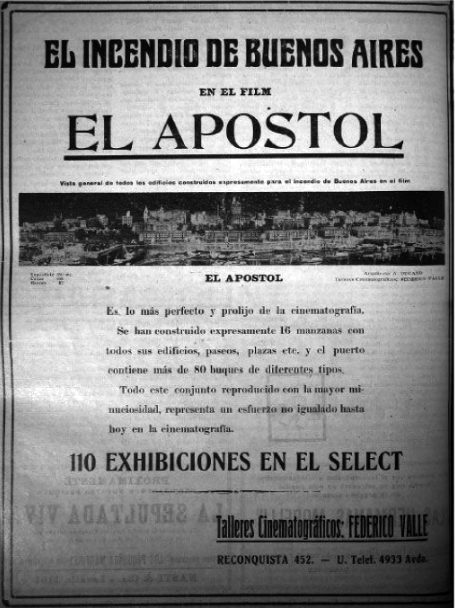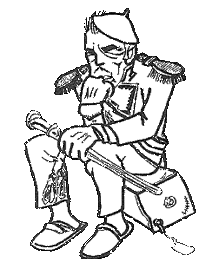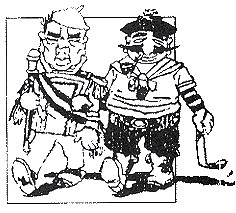El Apóstol (lost Argentinian first feature animated film; 1917): Difference between revisions
No edit summary |
RockinGuy728 (talk | contribs) No edit summary |
||
| (32 intermediate revisions by 13 users not shown) | |||
| Line 1: | Line 1: | ||
'''''El Apóstol''''' (aka ''The Apostle'') | {{InfoboxLost | ||
|title=<center>El Apóstol</center> | |||
|image=El_Apostol_flyer.png | |||
|imagecaption=Flyer advertising the film. | |||
|status=<span style="color:red;">'''Lost'''</span> | |||
}} | |||
'''''El Apóstol''''' (aka ''The Apostle'') is a 1917 Argentine silent black-and-white animated film.<ref>[http://awn.com/mag/issue1.4/articles/bendazzi1.4.html Page about Quirino Cristiani (also source of pictures).] Retrieved 18 Mar '16</ref> It was directed, written, designed and animated by Quirino Cristiani, whose two other animated features are also lost (''[[Sin Dejar Rastros (lost Argentinian animated film; 1918)|Sin Dejar rastros]]'' and ''[[Peludopolis (partially found Argentinian animated film; 1931)|Peludópolis]]''). | |||
It | It is considered to be the first animated feature film (being 70 minutes long with a framerate of 14 frames per second), but all known copies were destroyed in a fire in 1926. | ||
==Design== | |||
Instead of using traditional celluloid animation, Cristiani would use flat paper cut-out puppets with rotating/removable members. Character designs were made by Diógenes Taborda, a popular cartoonist at the time. | |||
The | ==Premise== | ||
The film was a political satire about then-Argentine-president Hipolito Yrigoyen, who wants to cleanse Buenos Aires of immorality and corruption. | |||
Yrigoyen flies into heaven and encounters the god of thunder, Jupiter. Using his lightning bolts, Yrigoyen strikes Buenos Aires, and the city is engulfed in flames, burning into ashes, before he decides to start rebuilding the city. | |||
No | He then awakens, finding out that this was all a dream and is forced to face the harsh reality of complicated politics. | ||
Cristiani would later make another political satire animated feature | |||
==Legacy== | |||
No stills or posters of the film remain, apart from a flyer advertising the film, a few character designs by Taborda and a photograph of the Buenos Aires model, as seen below.<ref>[http://quirinocristianimovie.com ''Quirino Cristiani: The Mystery of the First Animated Movies'' documentary.] Retrieved 23 Mar '19</ref> | |||
Cristiani would later make another political satire animated feature about Yrigoyen: [[Peludopolis (partially found Argentinian animated film; 1931)|''Peludopolis'']]. | |||
==Gallery== | |||
<gallery mode=packed heights=175px> | <gallery mode=packed heights=175px> | ||
File:Irigoyen.gif|Character design of | File:Irigoyen.gif|Character design of Yrigoyen for the film, by Diógenes Taborda. | ||
File:El_apostol.gif|Another character design by Diógenes Taborda. | File:El_apostol.gif|Another character design by Diógenes Taborda. | ||
File:Ducaud.jpg|Model of Buenos Aires used for the ending. | File:Ducaud.jpg|Model of Buenos Aires used for the ending. | ||
</gallery> | </gallery> | ||
==Video== | |||
{{Video|perrow =2 | |||
|service1 =youtube | |||
|id1 =nwPIhXbqfg8 | |||
|description1 =XtR's video on this subject | |||
|service2 =youtube | |||
|id2 =BBTHobNy9gU | |||
|description2 =El Debate's video on this subject | |||
}} | |||
==References== | ==References== | ||
{{reflist}} | |||
[[Category:Lost animation|Apóstol, El]] | |||
[[Category:Lost films|Apóstol, El]] | |||
[[Category:Lost animation]] | [[Category:Historic|Apóstol, El]] | ||
[[Category:Lost films]] | [[Category:Completely lost media|Apóstol, El]] | ||
Latest revision as of 06:48, 19 March 2024
El Apóstol (aka The Apostle) is a 1917 Argentine silent black-and-white animated film.[1] It was directed, written, designed and animated by Quirino Cristiani, whose two other animated features are also lost (Sin Dejar rastros and Peludópolis).
It is considered to be the first animated feature film (being 70 minutes long with a framerate of 14 frames per second), but all known copies were destroyed in a fire in 1926.
Design
Instead of using traditional celluloid animation, Cristiani would use flat paper cut-out puppets with rotating/removable members. Character designs were made by Diógenes Taborda, a popular cartoonist at the time.
Premise
The film was a political satire about then-Argentine-president Hipolito Yrigoyen, who wants to cleanse Buenos Aires of immorality and corruption.
Yrigoyen flies into heaven and encounters the god of thunder, Jupiter. Using his lightning bolts, Yrigoyen strikes Buenos Aires, and the city is engulfed in flames, burning into ashes, before he decides to start rebuilding the city.
He then awakens, finding out that this was all a dream and is forced to face the harsh reality of complicated politics.
Legacy
No stills or posters of the film remain, apart from a flyer advertising the film, a few character designs by Taborda and a photograph of the Buenos Aires model, as seen below.[2]
Cristiani would later make another political satire animated feature about Yrigoyen: Peludopolis.
Gallery
Video
References
- ↑ Page about Quirino Cristiani (also source of pictures). Retrieved 18 Mar '16
- ↑ Quirino Cristiani: The Mystery of the First Animated Movies documentary. Retrieved 23 Mar '19



